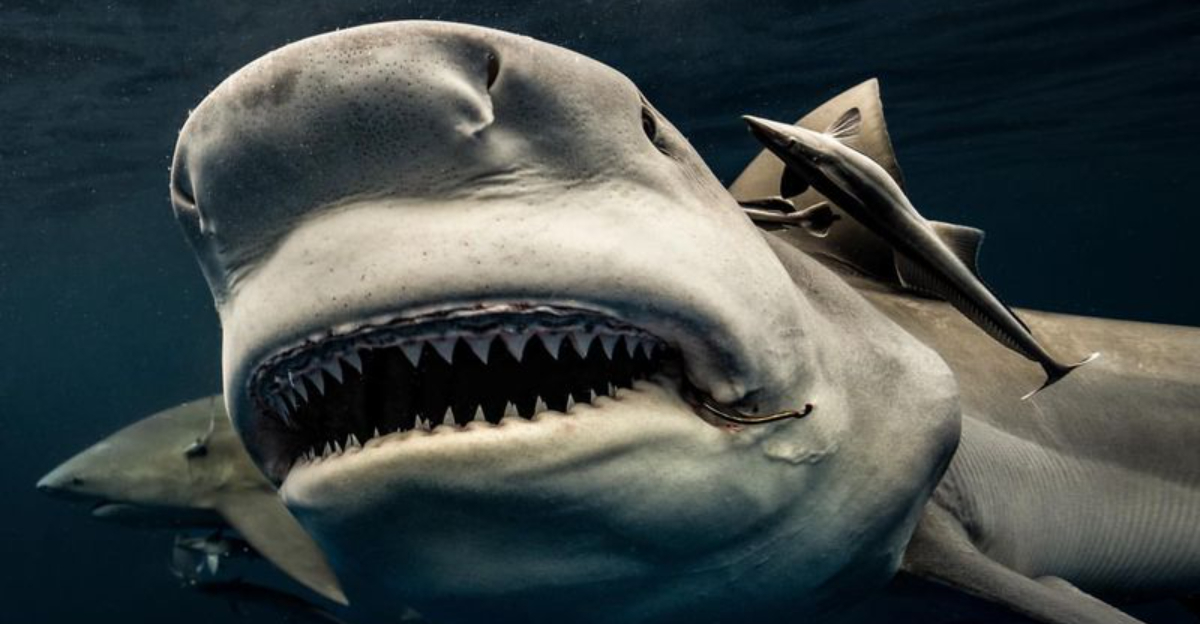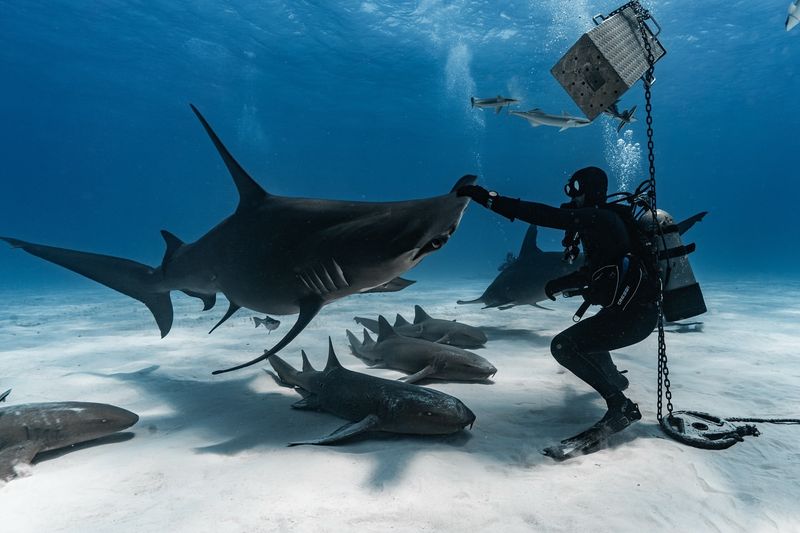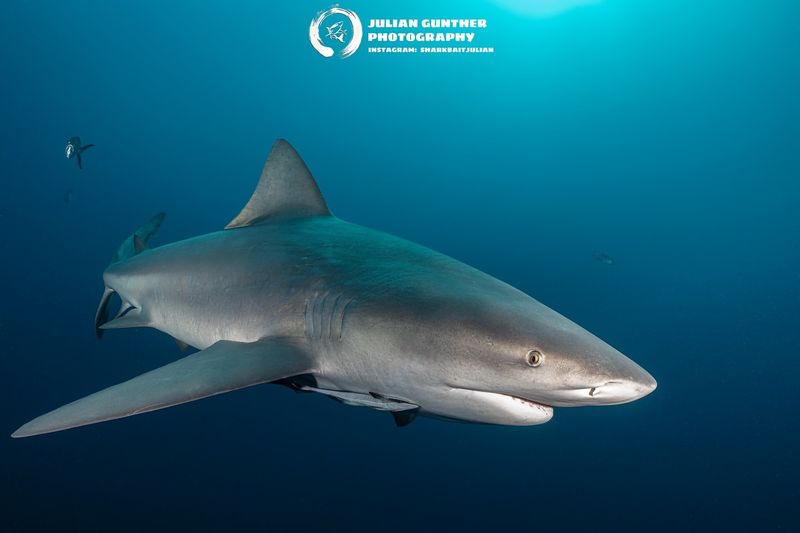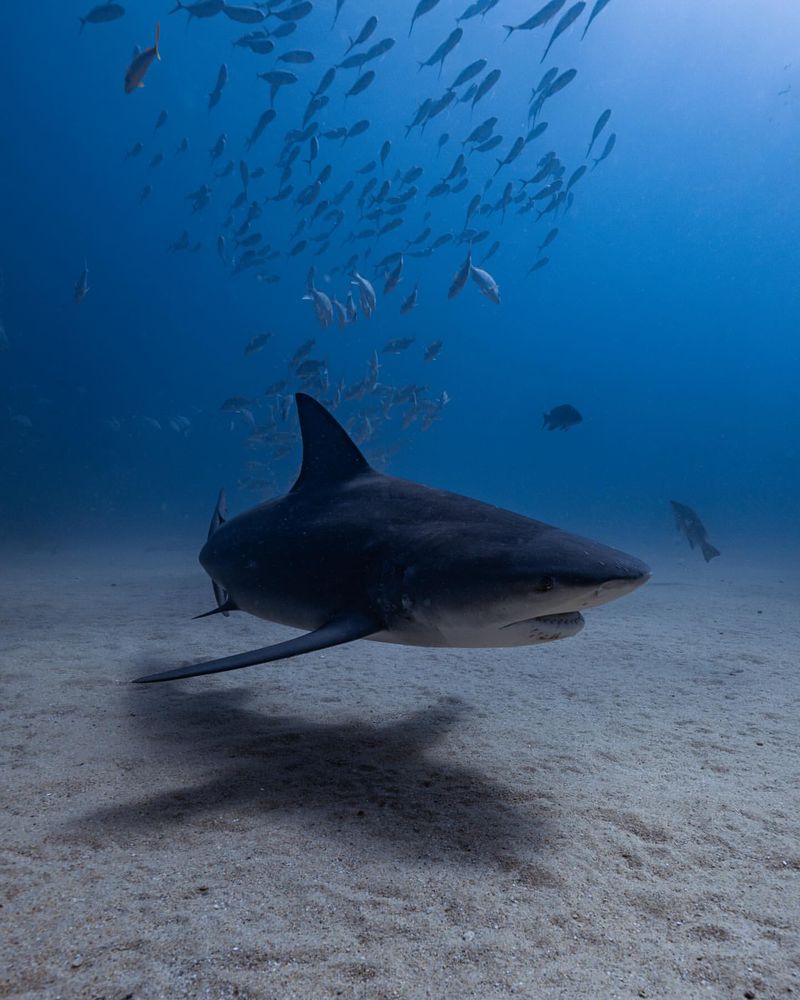21 Facts About Mississippi River Sharks Everyone Should Know

The Mississippi River, known for its vast expanse and diverse ecosystem, is home to many surprising residents, including the elusive and rarely seen river sharks.
While the idea of sharks swimming through freshwater rivers might seem unusual, certain species, like the bull shark, have adapted to these environments, making their way into the Mississippi River.
From their ability to survive in both saltwater and freshwater to the myths and legends surrounding them, Mississippi River sharks are a fascinating and mysterious part of the region’s wildlife.
1. Adaptability Of Bull Sharks

Bull sharks are renowned for their remarkable adaptability, enabling them to thrive in both saltwater and freshwater environments. This unique ability is attributed to their kidneys’ high efficiency at recycling salt and their liver’s role in managing buoyancy. Found in oceans and rivers alike, bull sharks stand out for their tolerance to various salinities.
In the Mississippi River, this adaptability means bull sharks can journey far inland, often being spotted thousands of miles from the ocean. Their robust physiological adaptations facilitate their survival in diverse conditions, contributing to their reputation as one of the most versatile shark species.
Understanding how bull sharks adjust to differing habitats provides insight into their evolutionary success and highlights their role in both marine and freshwater ecosystems. They serve as an important reminder of nature’s incredible ability to adapt and thrive in unexpected places.
2. Diet And Hunting Skills

Bull sharks are apex predators, renowned for their voracious appetite and advanced hunting skills. Their diet primarily consists of fish, but they are not averse to consuming birds, turtles, and even other sharks. In the Mississippi River, bull sharks exploit their keen senses to detect prey, often using the murky waters to their advantage.
Their hunting prowess is further enhanced by their ability to detect electrical fields produced by other animals, allowing them to locate hidden prey with remarkable precision. This skill is particularly useful in the river’s dark and often turbulent waters, where visibility is limited.
Observing bull sharks’ hunting strategies provides valuable insights into their behavior and ecological impact. As efficient predators, they play a crucial role in maintaining the balance of the river’s ecosystem, keeping fish populations in check and ensuring the health of the aquatic food web.
3. Bull Sharks’ Unique Reproduction

Bull sharks exhibit fascinating reproductive behaviors that set them apart from many other shark species. They give birth to live young, known as pups, rather than laying eggs. This viviparous reproduction provides the pups with immediate mobility and a better chance of survival in the early stages of life.
In the Mississippi River, pregnant bull sharks seek out calm, shallow waters to give birth, ensuring a safe environment for their offspring. This strategy minimizes the risk of predation and enhances the pups’ chances of reaching maturity.
Understanding the reproductive habits of bull sharks offers insights into their life cycle and survival strategies. It also sheds light on the broader ecological dynamics of the Mississippi River, where these sharks play a vital role in the food chain and overall ecosystem health.
4. Role In The Ecosystem

Bull sharks are integral components of the Mississippi River ecosystem, influencing both the aquatic and terrestrial environments. As top predators, they regulate fish populations, preventing overpopulation and promoting biological diversity. Their presence affects the behavior and distribution of other species, contributing to a balanced and dynamic ecosystem.
These sharks also impact the river’s nutrient cycle, as their hunting activities facilitate the transfer of energy and nutrients between different trophic levels. Through predation, bull sharks help recycle organic matter, supporting the growth of various organisms.
Examining the ecological role of bull sharks in the Mississippi River underscores their importance in maintaining the health and stability of the ecosystem. Their interactions with other species highlight the intricate web of relationships that sustain life in this diverse and vital waterway.
5. Size And Physical Features

Bull sharks are known for their impressive size and distinctive physical features, which equip them for survival in diverse environments. Typically, adult bull sharks measure between 7 to 11 feet in length and can weigh up to 500 pounds. Their robust, muscular bodies and blunt snouts distinguish them from other shark species.
One of the most striking features of bull sharks is their powerful jaw, lined with razor-sharp teeth. This adaptation allows them to efficiently capture and consume a variety of prey, from fish to larger mammals. Their body coloration, a muted gray on top with a lighter underside, provides effective camouflage in both ocean and river settings.
Exploring the physical characteristics of bull sharks helps us understand their dominance as predators and their adaptability to different habitats. Their size and strength make them formidable creatures, capable of thriving in the challenging environments of the Mississippi River.
6. Migration Patterns

Bull sharks exhibit intriguing migration patterns, often traveling long distances between saltwater and freshwater environments. In the Mississippi River, these movements are influenced by factors such as food availability, environmental conditions, and breeding needs.
Their ability to traverse vast distances is made possible by physiological adaptations that allow them to tolerate varying salinities. This means bull sharks can journey from the Gulf of Mexico deep into the river, often covering hundreds of miles. Such migrations play a crucial role in their life cycle, affecting mating, birthing, and foraging behaviors.
Understanding the migration patterns of bull sharks provides insights into their ecological role and the challenges they face in a changing environment. These journeys reflect their adaptability and the interconnectedness of marine and freshwater ecosystems, highlighting the importance of conserving these dynamic habitats.
7. Interaction With Humans

Bull sharks have a complex relationship with humans, fueled by both fascination and fear. In the Mississippi River, they are often subjects of intrigue due to their unexpected presence in freshwater. While they are known for their aggressive nature, actual attacks on humans are rare.
Most encounters with bull sharks occur while fishing or boating, and maintaining a respectful distance ensures safety for both parties. Education and awareness about these creatures can help mitigate fear and promote coexistence, emphasizing the importance of sharks in maintaining ecological balance.
Bull sharks also contribute positively to local economies, attracting tourists and researchers interested in studying their behavior. This interaction with humans highlights the need for responsible wildlife management and conservation efforts to protect these vital apex predators and their habitats.
8. Conservation Status And Efforts

The conservation status of bull sharks is a subject of growing concern, as their populations face threats from habitat loss, pollution, and overfishing. In the Mississippi River, conservation efforts focus on preserving water quality and protecting critical habitats to support bull shark populations.
These initiatives involve collaboration between scientists, environmental organizations, and local communities to implement sustainable practices and raise awareness about the importance of sharks in the ecosystem. Efforts to reduce pollution and regulate fishing activities are crucial steps in ensuring the long-term survival of bull sharks.
Understanding the challenges faced by bull sharks and the ongoing conservation efforts highlights the need for continued vigilance and commitment to protecting these remarkable creatures. Their presence in the Mississippi River serves as an indicator of the health of the ecosystem, underscoring the importance of preserving our natural waterways.
9. Historical Sightings

Historical records of bull shark sightings in the Mississippi River date back several decades, intriguing locals and researchers alike. These sightings have been documented in newspapers and journals, sparking interest and often disbelief at the presence of such formidable creatures in freshwater.
The earliest accounts describe bull sharks being caught by fishermen or observed near riverbanks, often leading to sensational stories and heightened local curiosity. These historical encounters have contributed to our understanding of bull shark behavior and migration patterns, highlighting their ability to adapt to diverse environments.
Reflecting on past sightings provides valuable context for current research and conservation efforts, reinforcing the significance of monitoring and studying these sharks to better understand their role in the ecosystem. The legacy of these historical encounters continues to influence the fascination and awe surrounding bull sharks in the Mississippi River.
10. Scientific Research And Studies

Scientific research on bull sharks in the Mississippi River has provided valuable insights into their biology, behavior, and ecological impact. Studies focus on understanding their migration patterns, reproductive habits, and interactions with other species, contributing to a comprehensive knowledge of these versatile predators.
Researchers often employ advanced technologies such as satellite tagging and genetic analysis to track bull shark movements and gather data on their population dynamics. These studies help identify critical habitats and inform conservation strategies aimed at protecting these unique animals.
The ongoing scientific exploration of bull sharks in the Mississippi River underscores the importance of continued research and collaboration between scientists, conservationists, and local communities. By advancing our understanding of bull sharks, we can better ensure their survival and maintain the health and balance of the river’s ecosystem.
11. Adaptations For Freshwater Living

Bull sharks possess several key adaptations that allow them to thrive in freshwater environments like the Mississippi River. Their kidneys are particularly efficient at recycling salt, a crucial ability given the low salinity levels in freshwater. This physiological adaptation helps maintain their osmotic balance, allowing them to survive and prosper far from the ocean.
Additionally, their liver produces a compound called urea, which aids in buoyancy and further enhances their ability to adapt to different water conditions. This complex interaction of physiological traits underscores their evolutionary success and ability to colonize diverse habitats.
Exploring these adaptations provides insight into the bull sharks’ resilience and flexibility in responding to changing environmental conditions. Their presence in the Mississippi River exemplifies the remarkable ways in which some species have evolved to exploit both marine and freshwater resources, contributing to their survival and success across vast geographical ranges.
12. Influence On Local Culture

Bull sharks have left a notable mark on the cultural landscape of communities along the Mississippi River. Their presence in freshwater has inspired local folklore and legends, often portraying them as mysterious and formidable creatures of the deep. These stories contribute to a rich tapestry of river lore, blending fact and fiction in captivating ways.
Art and literature from the region frequently feature bull sharks, reflecting their impact on local imagination and creativity. Whether depicted in paintings, sculptures, or written narratives, these sharks symbolize the untamed and unpredictable nature of the river itself.
Understanding the cultural significance of bull sharks in the Mississippi River enhances our appreciation of the intricate relationship between humans and the natural world. These cultural expressions highlight the enduring fascination and respect that these remarkable creatures inspire, reminding us of the profound connections we share with our environment.
13. Bull Sharks’ Threats And Predators

Bull sharks face various threats and predators, even as they occupy the top of the food chain in the Mississippi River. Human activities, such as pollution and habitat destruction, pose significant risks to their survival. Contaminants in the water can have detrimental effects on their health and reproductive success.
Although adult bull sharks have few natural predators, younger sharks may fall prey to larger fish or alligators inhabiting the river. This predation pressure is a natural part of the ecosystem, contributing to the balance of species and population dynamics.
Recognizing the threats faced by bull sharks underscores the need for effective conservation measures and responsible environmental stewardship. Protecting these creatures and their habitats is vital to ensuring the health and diversity of the Mississippi River ecosystem, allowing bull sharks to continue their role as apex predators in this unique and complex environment.
14. Unique Behavior Traits

Bull sharks are known for their distinctive behavior traits, making them a subject of intrigue for scientists and enthusiasts alike. One of the most notable characteristics is their curiosity, often leading them to investigate unfamiliar objects or environments. This trait, while fascinating, can sometimes bring them into closer contact with humans.
Another defining behavior is their aggression, which is partly why they are considered one of the more dangerous shark species. This aggression, however, is typically a response to perceived threats or competition for food, rather than unprovoked attacks.
Studying the behavior of bull sharks in the Mississippi River reveals a complex and adaptive predator, capable of thriving in diverse conditions. These unique traits contribute to their survival and success, highlighting the need for further research and understanding of their ecological role and interactions within the river ecosystem.
15. Bull Sharks In Popular Media

Bull sharks have captured the public imagination, often featured in documentaries, films, and news stories about river wildlife. Their ability to thrive in freshwater environments like the Mississippi River adds an element of intrigue and surprise, making them popular subjects for media coverage.
These portrayals often emphasize the bull shark’s adaptability and resilience, highlighting their role as apex predators in the ecosystem. Documentaries and educational programs aim to dispel myths and provide accurate information about their behavior, encouraging a deeper understanding and appreciation of these remarkable creatures.
The presence of bull sharks in popular media reflects society’s fascination with nature’s mysteries and the desire to explore the unknown. By raising awareness and promoting conservation efforts, media coverage plays a crucial role in protecting bull sharks and their habitats, ensuring their continued survival in the Mississippi River and beyond.
16. Interaction With Other Species

Bull sharks in the Mississippi River interact with a diverse array of species, contributing to the ecological complexity of the river. Their relationships with other fish, birds, and aquatic mammals shape the dynamics of the ecosystem, influencing food webs and species distribution.
As apex predators, bull sharks play a role in controlling the populations of various fish species, preventing overpopulation and maintaining ecological balance. Their presence also affects the behavior and movement patterns of other animals, prompting changes in habitat use and foraging strategies.
Understanding these interactions provides valuable insights into the interconnectedness of the river’s ecosystem and the importance of preserving its biodiversity. The coexistence of bull sharks with other species highlights the intricate web of life within the Mississippi River, emphasizing the need for conservation efforts to protect its unique and dynamic environment.
17. Bull Sharks’ Sensory Abilities

Bull sharks possess remarkable sensory abilities that enable them to navigate and hunt effectively in the Mississippi River’s often murky waters. Their keen sense of smell allows them to detect prey from great distances, while specialized sensory organs known as ampullae of Lorenzini help them perceive electrical fields produced by other animals.
These adaptations are particularly advantageous in the river’s low visibility conditions, allowing bull sharks to locate and capture prey with precision. Their acute senses are integral to their survival, supporting their role as top predators in the ecosystem.
Exploring the sensory abilities of bull sharks enhances our understanding of their behavior and ecological success. These traits not only illustrate the complexity of shark biology but also highlight the evolutionary adaptations that have enabled them to thrive in diverse environments, from the ocean to the freshwater reaches of the Mississippi River.
18. Impact Of Climate Change

The impact of climate change on bull sharks in the Mississippi River is an area of growing concern, as changing environmental conditions threaten their survival. Rising temperatures and altered precipitation patterns can affect water levels and salinity, challenging the adaptability of bull sharks to these new conditions.
Climate change may also influence the availability of prey and suitable habitats, further complicating the ecological balance of the river. These changes underscore the need for proactive conservation measures to mitigate the effects of climate change and protect the diverse species that inhabit the Mississippi River.
Understanding the implications of climate change on bull sharks highlights the broader challenges faced by aquatic ecosystems worldwide. By addressing these issues and promoting sustainable practices, we can help ensure the resilience and longevity of bull sharks and the rich biodiversity of the Mississippi River ecosystem.
19. Bull Sharks’ Lifespan And Growth

Bull sharks exhibit a fascinating growth and development process, with a lifespan that typically ranges from 12 to 16 years. From the moment they are born, these sharks begin a journey of rapid growth, with pups measuring about 2 to 3 feet in length at birth.
As they mature, bull sharks can reach impressive sizes, with adults ranging from 7 to 11 feet long. This growth is influenced by factors such as food availability, environmental conditions, and genetic predisposition. Throughout their lives, bull sharks continue to adapt to their surroundings, honing their hunting skills and navigating the challenges of their environment.
Understanding the lifespan and growth of bull sharks provides insight into their life cycle and ecological role in the Mississippi River. These insights contribute to our broader knowledge of shark biology and the factors that influence their survival and success in diverse habitats.
20. Bull Sharks Can Survive In Freshwater

Bull sharks are one of the few shark species known to thrive in both saltwater and freshwater environments. They have been spotted in the Mississippi River, demonstrating their remarkable adaptability.
Their ability to regulate their internal salt levels allows them to swim far from the ocean, even venturing into freshwater rivers.
21. Rare Sightings, Not A Common Occurrence

Although bull sharks have been known to travel into freshwater rivers like the Mississippi, sightings of sharks in the river are extremely rare.
The presence of sharks in freshwater is an exceptional event, and while the river does provide a habitat for these sharks, they are not commonly found in large numbers or on a regular basis.






